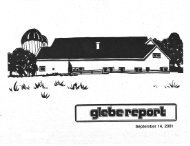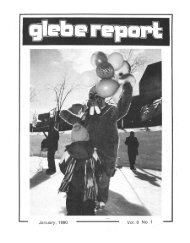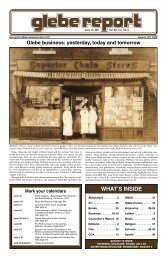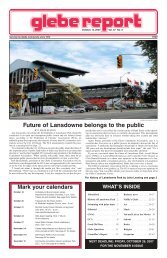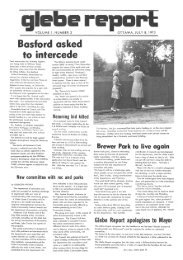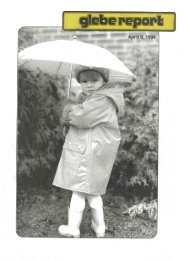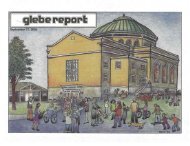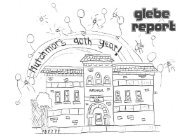April 16, 2010 - Glebe Report
April 16, 2010 - Glebe Report
April 16, 2010 - Glebe Report
Create successful ePaper yourself
Turn your PDF publications into a flip-book with our unique Google optimized e-Paper software.
NEWS<br />
The <strong>Glebe</strong>: A healthy<br />
neighbourhood for most<br />
BY JOHN JULIAN<br />
The <strong>Glebe</strong> is one of Ottawa’s most<br />
desirable neighbourhoods. It is distinctly<br />
hip and urban, yet it is also a<br />
family friendly place, full of beautiful,<br />
single family homes. No doubt,<br />
most residents also see it as a healthy<br />
place to live. But is it? A representative<br />
of the Centretown Community<br />
Health Centre will come to our<br />
neighbourhood to give a presentation<br />
on Thursday, <strong>April</strong> 29.<br />
Researchers from the Institute of<br />
Population Health at the University<br />
of Ottawa have recently completed a<br />
study which does a lot to answer that<br />
question. The Ottawa Neighbourhood<br />
Study is a multi-disciplinary project<br />
funded by the Canadian Institutes of<br />
Health Research in partnership with<br />
the City of Ottawa and community<br />
groups, including Centretown Community<br />
Health Centre (CCHC) which<br />
serves the <strong>Glebe</strong>. The researchers<br />
looked at a wide range of factors<br />
that can affect our health – income,<br />
social cohesion, housing, food, and<br />
access to health care – in more than<br />
90 neighbourhoods. The results are<br />
fascinating.<br />
For the most part, the findings for<br />
the <strong>Glebe</strong> are encouraging. On average,<br />
the 10,600 people who live in<br />
the <strong>Glebe</strong> are a well educated, affluent<br />
lot. In 2006, the average household<br />
income was nearly $115,000,<br />
almost $35,000 more than the city<br />
average, and 68 per cent of adults<br />
have a university education, compared<br />
to just 37 per cent for the city<br />
as a whole. Based on these and other<br />
factors, the <strong>Glebe</strong> falls into the most<br />
advantaged category of five used in<br />
the study. The neighbourhood has<br />
a good balance of age groups, with<br />
young adults and middle aged people<br />
in the majority. It is not a particularly<br />
diverse neighbourhood – only 8 per<br />
cent of the residents self-identify as<br />
visible minorities compared to 20 per<br />
cent for the city as a whole.<br />
Where health is concerned, the news<br />
is mostly good. More than 78 per cent<br />
of the people surveyed rated their<br />
health as good or excellent. That is not<br />
the best in the city, but certainly well<br />
above the Ottawa average of just 64.5<br />
per cent. Location plays a role in that.<br />
More than 30 per cent of the population<br />
walks or bikes to work, although<br />
the neighbourhood is slightly below<br />
average when it comes to available<br />
recreational facilities. People from the<br />
neighbourhood are significantly less<br />
likely to be hospitalized for conditions<br />
such as asthma, diabetes and angina<br />
than the average person in the city,<br />
and the frequency with which <strong>Glebe</strong><br />
residents visit emergency rooms is<br />
also significantly lower. For neighbourhood<br />
babies, there are fewer low<br />
birth-weights or preterm births than<br />
the average for the city.<br />
In spite of the number of people<br />
walking and biking, residents are no<br />
more or less likely to be physically<br />
active than the average Ottawa citizen.<br />
And while 34 per cent of residents<br />
18 and older consider themselves<br />
to be overweight or obese, this<br />
compares favourably with the city<br />
average of 48 per cent.<br />
There are a few less positive facts<br />
lurking in this mound of statistics.<br />
Not everyone in the neighbourhood<br />
is affluent. In fact, the percentage<br />
of people that fall below the low income<br />
cut off, a measurement that at<br />
one time might have been called the<br />
poverty line, is very close to the city<br />
average at 13 per cent and has been<br />
increasing in recent years. For those<br />
people, high rents and expensive real<br />
estate create serious challenges. In<br />
fact, 23 per cent of <strong>Glebe</strong> residents<br />
pay more than 30 per cent of their<br />
income for shelter, about average for<br />
Ottawa. That represents a significant<br />
number of people whose housing<br />
costs make it difficult to pay for other<br />
necessities. As well, 10 per cent of<br />
the housing is in need of major repair,<br />
which is above the city average.<br />
That may not be a huge surprise in an<br />
area where the majority of the homes<br />
are more than 70 years old, but housing<br />
issues – mould, poor ventilation,<br />
badly tuned furnaces – can have<br />
subtle health effects without people<br />
being aware.<br />
Food is probably the most important<br />
of the other necessities, and <strong>Glebe</strong><br />
residents are quite well served in that<br />
respect with easy access to healthy,<br />
reasonably priced food. There are<br />
two grocery stores and eight specialty<br />
food stores in the neighbourhood.<br />
On average people can walk to<br />
a grocery store in just seven minutes.<br />
In comparison, in some other neighbourhoods,<br />
residents are much more<br />
dependent on convenience stores for<br />
food.<br />
There are two pharmacies in the<br />
<strong>Glebe</strong>, about average for the city, and<br />
87 per cent of <strong>Glebe</strong> residents have<br />
a regular family doctor – again, very<br />
close to the city average.<br />
Simone Thibault, Centretown<br />
Community Health Centre’s executive<br />
director and a member of the<br />
study steering committee, says the<br />
study points to a healthy neighbourhood<br />
with all of the conditions necessary<br />
for people to live healthy<br />
lives. At the same time, she says,<br />
there is poverty hidden below the<br />
affluent surface of the neighbourhood.<br />
Affluence and poverty are key<br />
determinants of health, and people<br />
living below the low income cut<br />
off have much greater challenges in<br />
maintaining good health. The <strong>Glebe</strong><br />
is part of CCHC’s catchment area,<br />
and residents are welcome to access<br />
the services of physicians and nurse<br />
practitioners at the centre. However,<br />
she cautions that there is an unmet<br />
demand for physicians throughout<br />
the catchment area, and people can<br />
expect to spend some time on a waiting<br />
list before they are assigned to a<br />
doctor or nurse practitioner.<br />
<strong>Glebe</strong> Neighbourhood Profile Presentation<br />
Thursday, <strong>April</strong> 29, 7:15-9:30 p.m.<br />
Multi-Purpose Room<br />
<strong>Glebe</strong> Community Centre<br />
175 Third Avenue<br />
<strong>Glebe</strong> <strong>Report</strong> <strong>April</strong> <strong>16</strong>, <strong>2010</strong> 19<br />
Minimum wage changed<br />
March 31<br />
Minimum wage is the lowest wage rate an employer can pay an employee.<br />
Most employees are eligible for minimum wage, whether they are full-time,<br />
part-time, casual employees, or are paid an hourly rate, commission, piece<br />
rate, flat rate or salary. Some employees have jobs that are exempt from the<br />
minimum wage provisions of the Employment Standards Act, 2000 (ESA).<br />
(See “Industries and Jobs with ESA Exemptions and/or Special Rules” for<br />
information on these job categories.)<br />
Minimum Wage Rates<br />
MINIMUM WAGE RATE MARCH 31, 2009 MARCH 31, <strong>2010</strong><br />
General minimum wage $9.50/hr $10.25/hr<br />
Students minimum wage $8.90/hr $9.60/hr<br />
Liquor servers<br />
minimum wage<br />
Homeworkers wage<br />
(110% of general minimum wage)<br />
$8.25/hr<br />
$10.45/hr<br />
$8.90/hr<br />
$11.28/hr<br />
General minimum wage: This rate applies to most employees.<br />
Students: This rate applies to students under the age of 18 who work 28 hours<br />
a week or less when school is in session or work during a school break or summer<br />
holidays.<br />
Liquor servers: This hourly rate applies to employees who serve liquor directly<br />
to customers or guests in licensed premises as a regular part of their<br />
work. “Licensed premises” are businesses for which a license or permit has<br />
been issued under the Liquor Licence Act.<br />
Homeworkers: Homeworkers are employees who do paid work in their own<br />
homes. For example, they may sew clothes for a clothing manufacturer, answer<br />
telephone calls for a call centre, or write software for a high-tech company.<br />
Note that students of any age (including students under the age of 18 years)<br />
who are employed as homeworkers must be paid the homeworker’s minimum<br />
wage.<br />
Example for calculating general minimum wage: One week in <strong>April</strong> of <strong>2010</strong>,<br />
Julia works 37.5 hours. She is paid on a weekly basis. The minimum wage applicable<br />
to Julia is $10.25 per hour. Since compliance with the minimum wage<br />
requirements is based on pay periods, Julia must earn at least $384.38 (37.5<br />
hours × $10.25 per hour = $384.38) in this work week (prior to deductions).<br />
(Note that eating periods are not included when counting how many hours an<br />
employee works in a week).<br />
three-hour rule<br />
When an employee is required to report to work for a shift of 3 hours or<br />
longer but works less than three hours, he or she must be paid whichever of<br />
the following amounts is higher: three hours at the minimum wage, or the<br />
employee’s regular wage for the time worked.<br />
Example: If an employee who is a liquor server is paid $10.00 an hour and<br />
works only two hours, he or she is entitled to three hours at minimum wage<br />
(e.g., $8.90, the liquor servers minimum wage as of March 31, <strong>2010</strong> x 3 =<br />
$26.70) instead of two hours at his or her regular wage ($10.00 x 2 = $20.00).<br />
The rule does not apply to:<br />
1. students (including students over 18 years of age);<br />
2. employees whose regular shift is three hours or less;<br />
3. where the cause of the employee not being able to work at least three<br />
hours was beyond the employer’s control.<br />
Sourced from the Ontario Ministry of Labour, the information does not<br />
included rates for hunting and fishing guides who are admittedly few and<br />
far between in downtown Ottawa. For more details, go to www.ontario.ca/<br />
minimum wage, www.labour.on.ca/english/es or telephone Employment Standards<br />
Inquiries at 1-800-531-5551.<br />
Arum Food Market (Korean and Japanese Grocery)<br />
Home-made Kimchi, Sushi Grade Fish, Seaweed, Organic Tofu,<br />
Dumplings, Giftwares, Asian Tea Pots, Dishes<br />
For your party: custom order<br />
marinated Beef and Ribs (Bulgogi & Kalbi)<br />
512 Bank Street, (613) 233-<strong>16</strong>58 Arumfood@gmail.com<br />
Dolsot Cafe COUPON, 10% OFF<br />
Authentic Korean Dishs, No MSGs<br />
(Bibimpap; Bulgogi; Hot Tofu soup; Dumpling soup;<br />
Pork Bone-Potato soup, etc.--Table barbecue available)<br />
512 Bank Street, (613) 230-8488, Dolsotcafe@gmail.com<br />
Expiry Date: May 30, <strong>2010</strong>





